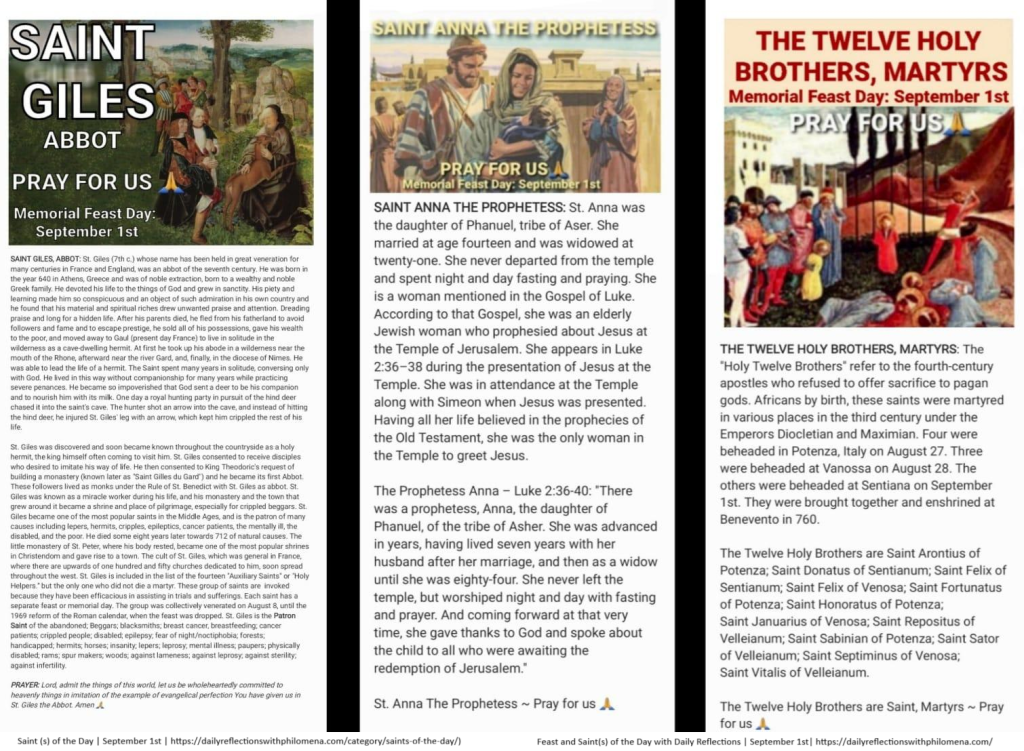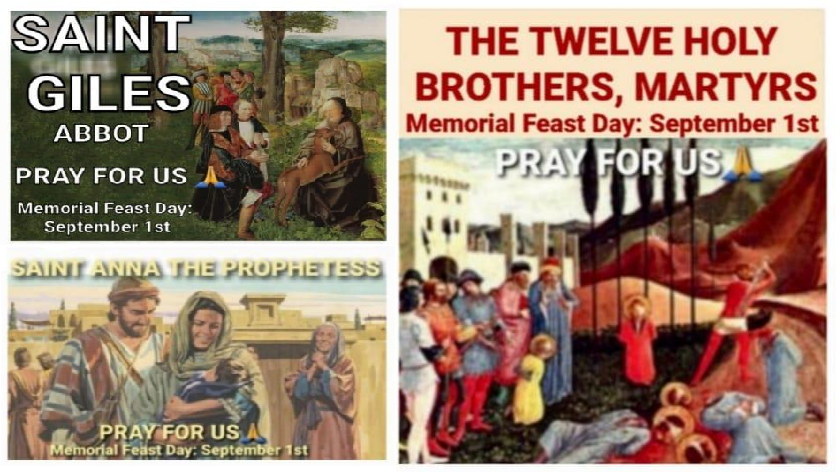
MEMORIAL OF SAINT GILES, ABBOT; SAINT ANNA THE PROPHETESS AND THE TWELVE HOLY BROTHERS, MARTYRS ~ FEAST DAY: SEPTEMBER 1ST: Today, we celebrate the Memorial of Saint Giles, Abbot; Saint Anna The Prophetess and The Holy Brothers, Martyrs. Today is also the World Day of Prayer for the Care of Creation. Through the intercession of our Blessed Mother Mary and the Saints on this feast day, we humbly pray for the repose of the souls of the faithful departed and we pray for those who mourn. We pray for all those who are physically disabled, we pray for the sick and dying, especially those suffering from cancers and other terminal diseases. We pray for those seeking for the fruit of the womb. We also pray for the poor and needy and for peace, love, and unity in our marriages, our families and our world. And we continue to pray for our Holy Father, the Bishops, the Clergy, for vocations to the priesthood and religious life, for the Church, for persecuted christians, for the conversion of sinners, and Christians all over the world.🙏
SAINT GILES, ABBOT: St. Giles (7th c.) whose name has been held in great veneration for many centuries in France and England, was an abbot of the seventh century. He was born in the year 640 in Athens, Greece and was of noble extraction, born to a wealthy and noble Greek family. He devoted his life to the things of God and grew in sanctity. His piety and learning made him so conspicuous and an object of such admiration in his own country and he found that his material and spiritual riches drew unwanted praise and attention. Dreading praise and long for a hidden life. After his parents died, he fled from his fatherland to avoid followers and fame and to escape prestige, he sold all of his possessions, gave his wealth to the poor, and moved away to Gaul (present day France) to live in solitude in the wilderness as a cave-dwelling hermit. At first he took up his abode in a wilderness near the mouth of the Rhone, afterward near the river Gard, and, finally, in the diocese of Nimes. He was able to lead the life of a hermit. The Saint spent many years in solitude, conversing only with God. He lived in this way without companionship for many years while practicing severe penances. He became so impoverished that God sent a deer to be his companion and to nourish him with its milk. One day a royal hunting party in pursuit of the hind deer chased it into the saint’s cave. The hunter shot an arrow into the cave, and instead of hitting the hind deer, he injured St. Giles’ leg with an arrow, which kept him crippled the rest of his life.
St. Giles was discovered and soon became known throughout the countryside as a holy hermit, the king himself often coming to visit him. St. Giles consented to receive disciples who desired to imitate his way of life. He then consented to King Theodoric’s request of building a monastery (known later as “Saint Gilles du Gard”) and he became its first Abbot. These followers lived as monks under the Rule of St. Benedict with St. Giles as abbot. St. Giles was known as a miracle worker during his life, and his monastery and the town that grew around it became a shrine and place of pilgrimage, especially for crippled beggars. St. Giles became one of the most popular saints in the Middle Ages, and is the patron of many causes including lepers, hermits, cripples, epileptics, cancer patients, the mentally ill, the disabled, and the poor. He died some eight years later towards 712 of natural causes. The little monastery of St. Peter, where his body rested, became one of the most popular shrines in Christendom and gave rise to a town. The cult of St. Giles, which was general in France, where there are upwards of one hundred and fifty churches dedicated to him, soon spread throughout the west. St. Giles is included in the list of the fourteen “Auxiliary Saints” or “Holy Helpers.” but the only one who did not die a martyr. These group of saints are invoked because they have been efficacious in assisting in trials and sufferings. Each saint has a separate feast or memorial day. The group was collectively venerated on August 8, until the 1969 reform of the Roman calendar, when the feast was dropped. St. Giles is the Patron Saint of the abandoned; Beggars; blacksmiths; breast cancer, breastfeeding; cancer patients; crippled people; disabled; epilepsy; fear of night/noctiphobia; forests; handicapped; hermits; horses; insanity; lepers; leprosy; mental illness; paupers; physically disabled; rams; spur makers; woods; against lameness; against leprosy; against sterility; against infertility.
PRAYER: Lord, admit the things of this world, let us be wholeheartedly committed to heavenly things in imitation of the example of evangelical perfection You have given us in St. Giles the Abbot. Amen 🙏
SAINT ANNA THE PROPHETESS: St. Anna was the daughter of Phanuel, tribe of Aser. She married at age fourteen and was widowed at twenty-one. She never departed from the temple and spent night and day fasting and praying. She is a woman mentioned in the Gospel of Luke. According to that Gospel, she was an elderly Jewish woman who prophesied about Jesus at the Temple of Jerusalem. She appears in Luke 2:36–38 during the presentation of Jesus at the Temple. She was in attendance at the Temple along with Simeon when Jesus was presented. Having all her life believed in the prophecies of the Old Testament, she was the only woman in the Temple to greet Jesus.
The Prophetess Anna – Luke 2:36-40: “There was a prophetess, Anna, the daughter of Phanuel, of the tribe of Asher. She was advanced in years, having lived seven years with her husband after her marriage, and then as a widow until she was eighty-four. She never left the temple, but worshiped night and day with fasting and prayer. And coming forward at that very time, she gave thanks to God and spoke about the child to all who were awaiting the redemption of Jerusalem.”
St. Anna The Prophetess ~ Pray for us 🙏
THE TWELVE HOLY BROTHERS, MARTYRS: The “Holy Twelve Brothers” refer to the fourth-century apostles who refused to offer sacrifice to pagan gods. Africans by birth, these saints were martyred in various places in the third century under the Emperors Diocletian and Maximian. Four were beheaded in Potenza, Italy on August 27. Three were beheaded at Vanossa on August 28. The others were beheaded at Sentiana on September 1st. They were brought together and enshrined at Benevento in 760.
The Twelve Holy Brothers are Saint Arontius of Potenza; Saint Donatus of Sentianum; Saint Felix of Sentianum; Saint Felix of Venosa; Saint Fortunatus of Potenza; Saint Honoratus of Potenza; Saint Januarius of Venosa; Saint Repositus of Velleianum; Saint Sabinian of Potenza; Saint Sator of Velleianum; Saint Septiminus of Venosa; Saint Vitalis of Velleianum.
The Twelve Holy Brothers, Martyrs ~ Pray for us 🙏
